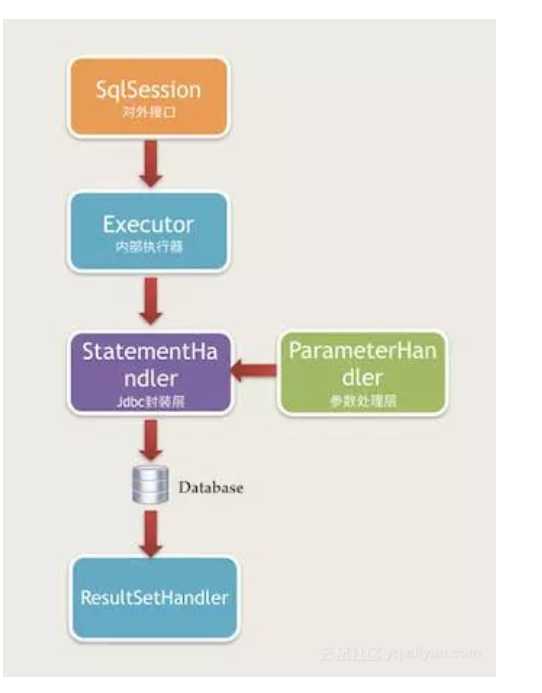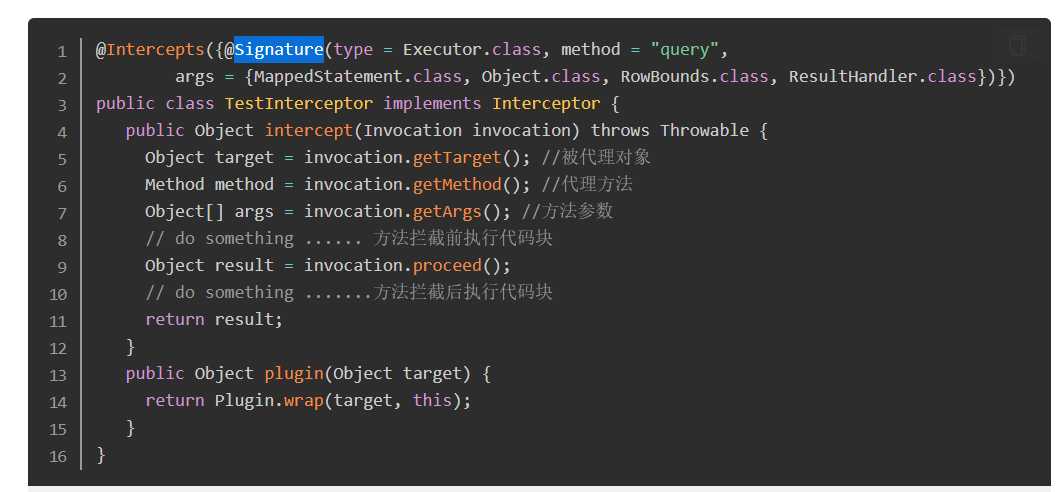1、作用
可以在sql执行前后 结果映射 参数解析阶段做拦截处理(AOP)
如:日志打印 性能监控等
2、拦截的4个对象
Execute StatementHandle ParameterHandle ResultHandle

3、使用
定义哪个对象 哪个方法进行拦截
如:plugin方法返回代理对象

4、原理
具体的方法定义可以参见每个类方法的签名,这里就不详细展开了。这四个类被创建后不是直接返回,而是创执行了interceptorChain.pluginAll(parameterHandler)才返回。如下所示:
pluginAll最终调用每个拦截器的plugin方法,返回代理对象,如果有多个拦截器,就会一层层代理。
//Configuration 中
public ParameterHandler newParameterHandler(MappedStatement mappedStatement, Object parameterObject, BoundSql boundSql) {
ParameterHandler parameterHandler = mappedStatement.getLang().createParameterHandler(mappedStatement, parameterObject, boundSql);
parameterHandler = (ParameterHandler) interceptorChain.pluginAll(parameterHandler);
return parameterHandler;
}
?
public ResultSetHandler newResultSetHandler(Executor executor, MappedStatement mappedStatement, RowBounds rowBounds, ParameterHandler parameterHandler,
ResultHandler resultHandler, BoundSql boundSql) {
ResultSetHandler resultSetHandler = new DefaultResultSetHandler(executor, mappedStatement, parameterHandler, resultHandler, boundSql, rowBounds);
resultSetHandler = (ResultSetHandler) interceptorChain.pluginAll(resultSetHandler);
return resultSetHandler;
}
?
public StatementHandler newStatementHandler(Executor executor, MappedStatement mappedStatement, Object parameterObject, RowBounds rowBounds, ResultHandler resultHandler, BoundSql boundSql) {
StatementHandler statementHandler = new RoutingStatementHandler(executor, mappedStatement, parameterObject, rowBounds, resultHandler, boundSql);
statementHandler = (StatementHandler) interceptorChain.pluginAll(statementHandler);
return statementHandler;
}
?
public Executor newExecutor(Transaction transaction) {
return newExecutor(transaction, defaultExecutorType);
}
?
// Execute默认使用SimpleExecutor
public Executor newExecutor(Transaction transaction, ExecutorType executorType) {
executorType = executorType == null ? defaultExecutorType : executorType;
executorType = executorType == null ? ExecutorType.SIMPLE : executorType;
Executor executor;
if (ExecutorType.BATCH == executorType) {
executor = new BatchExecutor(this, transaction);
} else if (ExecutorType.REUSE == executorType) {
executor = new ReuseExecutor(this, transaction);
} else {
executor = new SimpleExecutor(this, transaction);
}
if (cacheEnabled) {
executor = new CachingExecutor(executor);
}
executor = (Executor) interceptorChain.pluginAll(executor);
return executor;
}
5、总结
使用的设计模式:代理模式、责任链模式
参考:
https://www.cnblogs.com/chenpi/p/10498921.htm
https://www.cnblogs.com/zhjh256/p/11516878.html
https://my.oschina.net/u/4365042/blog/3344199l
原文:https://www.cnblogs.com/yangfei629/p/13460204.html